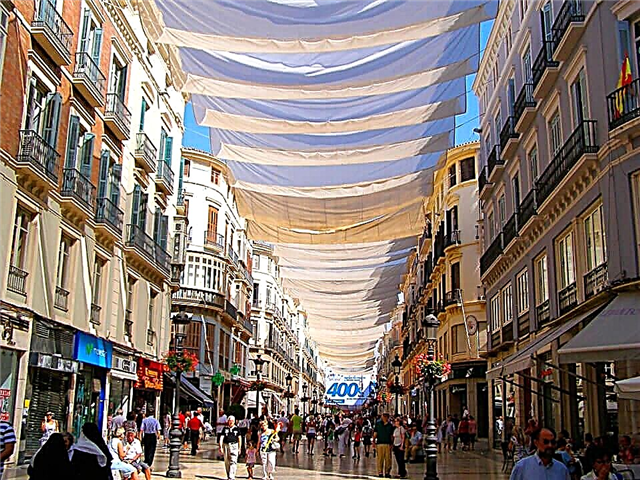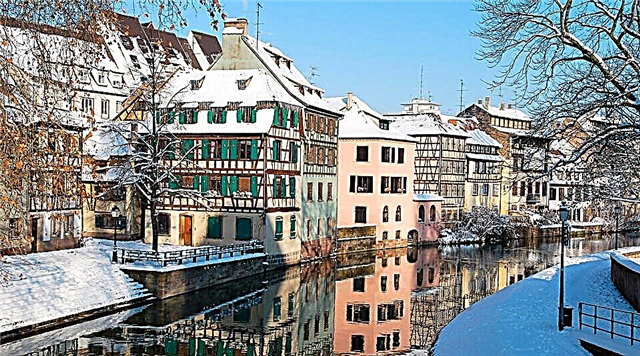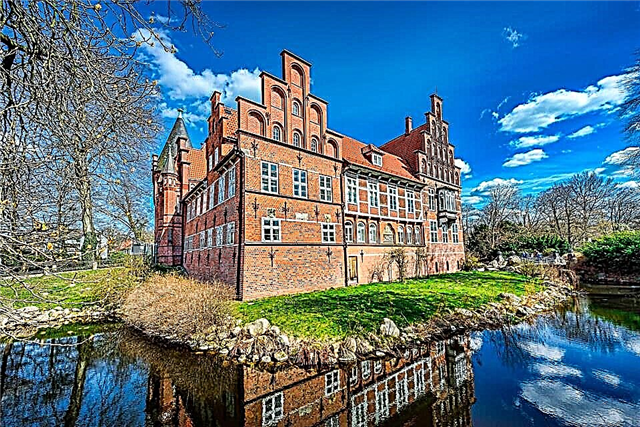In the north of Germany, on the banks of the full-flowing Elbe, is Hamburg - a port city and one of the 16 federal states of the country. Here, in the industrial capital of Germany, past and present, romance and pragmatism, a free spirit and a harsh character coexist. This place attracts with amazingly beautiful buildings, numerous bridges, quiet streets, museums and concert halls. But do not be confused by the huge number of attractions - many of them are compactly located in the historic center of the metropolis. What to see in Hamburg in one day on your own, you will learn from today's overview of the free Hanseatic city.
Miniature wonderland

In the heart of the bustling harbor atmosphere of Speicherstadt, a wonderland is rewarding - a mock-up of the northern railway and its surrounding areas, created in 2000 by Gerrit and Frederick Brown. The twin brothers decided to fulfill their childhood dream and created the largest toy railroad in the world. A year later, three sections appeared in the museum of miniatures, and in 2010 the model was completely ready. Today, the wonderland includes 15,400 meters of railroad tracks, 1,040 trains, 4,340 buildings and thousands of tiny trees, cars, lanterns and human figures.
Everything is real here: passenger trains arrive at the railway station, a plane is preparing for takeoff at the airport, residents of the Harz mountain climb to the top of Lysaya Gora, and football players score another goal into the goal at the Imtech Arena stadium. Guests of the mini-world can see not only the lands of Germany, but also Scandinavia, Switzerland, America, Austria and Italy.
The museum is located at Kehrwieder 2 and is open daily from 9:30 am to 7:00 pm.
Elbe Philharmonic and free observation deck

In January 2017, after a long 13 years of waiting, the Philharmonic opened in the HafenCity area. A total of EUR 789 million was spent on the construction of a 26-storey building with an area of 21,800 m2. The new cultural landmark looks like an outlandish sail. A glass structure of 1,000 panels rises on a brick base that used to be a warehouse. The curved shape and sun-protective coating provide a comfortable interior ambience.
The music complex includes three concert halls. Their walls are lined with consoles, each of which consists of a million cells that absorb and scatter sound waves. The main hall is designed according to the principle of a vineyard: the spectator seats are planned in such a way that each visitor is at a distance of no more than 30 meters from the orchestra. The Philharmonic also houses residential apartments and a hotel. There is a circular observation deck at a height of 37 m. You can get on it for free.
Address: Platz der Deutschen Einheit 1.
Dockland and free observation deck

Like the bow of a state-of-the-art ship, the Dockland rises above the Elbe, the most unusual parallelogram structure in the city, which appeared in 2006 on Van-der-Smissen-Str. 9. The six-storey building with a double glass façade, supported by a steel frame structure, has an area of 7,000 m2 used for office space.
Two panoramic elevators connecting the floors of the Dockland, built on a pier in the middle of the water. 136 steps with an inclination of 60 ° lead to the roof of the building. A reward awaits those who overcome them - an impressive view of the harbor, opening from the observation deck located at an altitude of 47 m.
Botanical Garden

On St. Petersburger Straße 28, a short walk from the Hamburg Dammtor S-Bahn station, the botanical garden is like a green forest decorated with exotic plants and flowers. The natural oasis was founded in 1821 by the botanist Johann Lehmann. For a long period, the territory was owned by its creator, but over time it passed into the possession of the city and became a public place. At the heart of the garden are five greenhouses representing a collection of tropical plants and succulents.
The Botanical Garden offers its guests not only a walk in the park area of 24 hectares. The green lungs of Hamburg give you the opportunity to travel the world for free and get acquainted with the various landscapes and flora of the planet: see the plants that inhabit the Balkans, Carpathians and Alps, visit the corner of China and Japan, admire the Biblical Garden of Jerusalem.
Hamburg City Hall

In the center of the metropolis, the town hall flaunts, strikingly different from typical Hamburg buildings. The sandstone and granite structure evokes a neo-Renaissance castle. Erected in 1886-1897, the building is today the seat of the municipality and city administration. In 1842, a fire destroyed the Hamburg City Hall. The new town hall was opened 55 years later. The niches of the luxurious facade of the building, which stands on 4,000 oak piles, are decorated with 20 statues of the emperors of Germany.
The main gate is dominated by a 112-meter Baroque tower topped with a massive spire. Behind the decorative wrought-iron latticed door of the main portal is the entrance to the hall, which reveals 16 monumental columns and 68 portraits of famous citizens of the city. Two Sardinian marble staircases lead to the premises of the Senate and the Legislative Assembly. In total, the building has 647 rooms, each of which has unique interiors.
You can get acquainted with the attraction as part of the excursion. Visiting times: from 11:00 to 16:00 (Monday-Friday), from 10:00 to 17:00 (Saturday) and from 10:00 to 16:00 (Sunday).
Reeperbahn

“Mile of Sin” is the name given to the townspeople on a street in the St. Pauli area that leads to the city's harbor. Known as the heart of Hamburg's nightlife since the 19th century, this place attracts dance, alcohol and adult lovers every night. There are sex shops, casinos, restaurants, trendy discos and the infamous red light district - legal brothels. The most striking sights are the St. Pauli Theater, the interiors of which have been preserved since 1841, the Rock and Roll House cafe and the Indra nightclub, where the legendary The Beatls performed in 1960.
In the morning, when the neon lights go out, the Reeperbahn turns into a calm street. Here you can plunge into the atmosphere of a Hanseatic city, go shopping, sit in one of the many cafes and admire replicas of prominent personalities in the Wax Museum.
Elbe tunnel

In 1907, the rapid development of the port prompted the construction of a tunnel to provide a link between the northern and southern banks of the Elbe. In 1911, the 426 m long structure, located at a depth of 23 m, celebrated its opening. Not only pedestrians could move along the underground passage - the dimensions of the two pipe-like structures allowed horse-drawn carriages to pass. And although in 1975 a new modern overpass appeared under the river, the old tunnel continues to perform a transport function today.
You can get inside the structure using elevators or stairs. The walls of the underground corridors are decorated with ceramic tiles covered with a special film. It makes even the slightest water smudges noticeable. About 300,000 cars cross the Elbe's brightly lit galleries every year. The fare is € 2.50. Cyclists and pedestrians can use the crossing for free.
Alster lake

Hamburg, already rich in waterways, is also famous for its man-made reservoir - Lake Alster, located in the center of the metropolis. The idea of creating a city reservoir belonged to Count Adolph III, by whose order in 1190 work began to divert one of the tributaries of the Elbe and block it with a dam. The created lake consisted of two parts: an internal Alster with an area of 18 hectares and an external one, stretching for 164 hectares.
The coastal area of the reservoir is occupied by a park - a favorite resting place for townspeople and tourists. A 7-kilometer trail has been laid here, which is loved by fans of a healthy lifestyle. The green zone is especially beautiful in spring, during the cherry blossom season. Every year in April, the Japanese community, which donated exotic trees to the city, organizes fireworks. All guests of the park and the rich inhabitants of the luxurious villas located on the lake embankment can watch the wonderful spectacle.
Zoo

The Hagenbeck Zoological Park (Tierpark Hagenbeck) is not just a zoo. This is an entertainment center and a natural natural area, where the inhabitants of the world of fauna freely live. In 1907, German merchant, trainer and passionate animal collector Karl Hagenbeck made his dream come true - he founded a park where the four-legged and winged inhabitants of the planet lived in harmony with the environment. The zoo is still owned by the descendants of Karl.
On an area of 25 hectares, there are no usual cells. More than 200 species of animals are freely placed in open spaces, separated from the audience by moats with water. The exception is predators - large enclosures are equipped for them. At the main entrance, visitors are greeted by a tropical aquarium with an area of 8,000 m2 - home to reptiles, amphibians and inhabitants of the ocean depths. In addition, fascinating shows with the participation of trained animals are regularly held on the territory of the zoo. And for young guests, a sector with tame animals is open, which can be reached by a miniature railway.
Address: Lokstedter Grenzstraße 2. Entrance fee for adults is 30 €, for children - 21 €.
Fish market

For more than 300 years, the traditional market at Große Elbstraße 9 has been selling everything your heart desires: fresh fish, seafood, vegetables, fruits, clothing, flowers and souvenirs. Every Sunday about 70,000 visitors flock to the huge plaza off the port. Citizens rush to shop, tourists stroll between the rows, listening to loud inviting speech and funny jokes of sellers. Only here you can taste the signature fast food of the northern city: sandwiches with smoked eel and herring.
If you want to visit the bazaar, prepare for an early rise. From April to October, trading is carried out 05:00 to 9:30, from November to March - from 7:00 to 9:30. Another feature of the market is the adjacent fish auction. Tired night out on a voyage through the entertainment venues of the Reeperbahn gather here for breakfast accompanied by live music.
Advice. After a stroll through the market, take a look at the nearby historic district of Altona, a former port formerly owned by Denmark.
Bergedorf Castle

In order to visit the only surviving castle in Hamburg - Bergedorf (Das Bergedorfer Schloss), you need to leave the center of the metropolis and go to its outskirts - to the town of Bergedorf. Here, on a small island formed by the Billy River, there is an architectural monument surrounded by a park and a double protective moat.
The castle was first mentioned in the chronicles of the 13th century. Then it was a defensive structure, protected by a palisade. The building acquired its current appearance, combining neo-Gothic and half-timbered styles, in the 16th century: it is a structure measuring 30 x 30 m, including massive towers, four wings and a drawbridge. The history of Bergedorf can be found in the mountain village museum, which holds regular exhibitions on the culture of the region.
Address: Bergedorfer Schloßstraße 4. The museum is open from Tuesday to Sunday from 11:00 to 17:00.
Hamburg Opera House

The history of the city's cultural center - the opera house (Staatsoper) - dates back to the middle of the 17th century. The construction of the Melpomene temple began at the initiative of wealthy local residents who dream of the appearance of a public music scene in the city. Its opening took place in January 1678 and was marked by the premiere of the opera Adam and Eve.
At first, self-taught singers performed on the wooden stage of the Staatsoper, and the repertoire depended on the tastes of wealthy citizens, the royal court and the clergy. A professional troupe and new areas of art (comic plays, overtures, dance inserts) appeared at the beginning of the 18th century. During the Second World War, the building was damaged by an air raid and was rebuilt only in 1955. In 2005, a modern building was erected next to the old building - a new opera house with an area of 8,500 m2.
Address: Große Theaterstraße 25.
St. Michael's Church

"Big Mikhel" - this is how the locals call the main Protestant temple, a famous landmark and symbol of the city. The first Gothic cathedral, erected in 1669, was destroyed by a lightning strike. A tragic fate befell the second temple, which fell victim to the fire. The modern church appeared on Englische Planke 1 in 1912.
The bell tower with a round clock, rising 132 meters into the sky, can be seen from afar. At a height of 110 meters, there is an observation platform, to which a spiral staircase leads. The austere lines and black color of the tower blend beautifully with the baroque red-brick church building, decorated with gilded elements, reliefs and limestone pilasters.
Above the entrance is the bronze Archangel Michael, piercing the defeated Satan with a spear. The nave is 27 m high and 71 m long. The white walls of the interior of the church are decorated with decorative columns with gilded stucco molding, paintings with biblical subjects and four organs. The centerpiece of the interior is a 20-meter marble altar. Members of the influential families of Hamburg are buried under the nave, in the temple crypt.
Opening hours: daily from 10:00 to 18:00 from November to April and from 9:00 to 20:00 from May to October.
Port of Hamburg

The harbor of the Hanseatic city is the largest seaport in Germany and one of the highest throughput ports on the planet. It is not for nothing that the metropolis is called the "Gate of the World". Every year up to 13,000 ships arrive here, and their number is constantly growing. The harbor, whose venerable age exceeds 825 years, covers an area of 73.99 km2, which is about one-tenth the size of Hamburg. The length of the berthing line is 275 km.
The history of the harbor dates back to 1189, when King Frederick I gave the city a great honor by granting it the exclusive privilege of levying customs tax on all ships that transported merchant cargo along the Elbe. Thanks to the development of the port, Hamburg also flourished. The architectural ensemble of Germany's sea gates has evolved over the centuries.
Here you will find Gothic buildings made of red brick, inherent in the appearance of all the cities of the Hansa (trade union of Europe), and futuristic buildings of our time.
For an overview of the harbor, we recommend taking one of the many longboat excursions. The pier is located in the Elbbahnhof, next to the Landungsbrücken pier. Ticket prices range from 12 to 18 euros.
Planetarium

Every year more than 300,000 people go on a journey through the vastness of the universe in the "star theater". The planetarium, which occupies the premises of the former water tower, appeared in the city park in 1930. Today, the facade of the building is decorated with columns, illuminated by searchlights at night. The central domed hall with 360 ° view is 21 m high and consists of 40 million points (8K resolution).
This is the world's first planetarium where breathtaking ultra-clear 3D images are merged with 3D sound. The picture of the starry sky is accurately reproduced by 9 Carl Zeiss laser projectors and 70 mirrors. After the spectacular show, visitors can grab a bite to eat at Café Nordstern and climb up to the observation deck at 40 m.
The planetarium is open from 09:00 to 17:00 (Monday – Tuesday), from 09:00 to 21:00 (Wednesday – Thursday), from 9:00 to 22:00 (Friday), from 10:00 to 22:00 (Saturday), from 10:00 to 20:00 (Sunday). Address: Linnering 1.
Humburger Dom amusement park

Three times a year, against the backdrop of the night sky above St. Pauli, the 60-meter Ferris wheel lights up with hundreds of lights, the aromas of waffles and toasted almonds soar in the air, and the heralds announce the start of the hip-hop dance competition.This means that the time has come for the Humburger Dom festival - the famous fair of the northern metropolis.
The Hamburg House is part of the city's history. The name of the amusement park was given by merchants, itinerant artists and artisans, who in 1337 got the opportunity to organize a market under the arches of Mariendom - the first Christian cathedral. At the end of the 19th century, by order of the city authorities, the fair acquired a new address - the Field of the Holy Spirit (Heiligengeistfeld).
Since then, in the spring (in March), in the summer (in July and August) and in the fall (in November), an area of 20 hectares has been transformed into an amusement park for 4 weeks. Vendors in tents lined up along the street offer toys, souvenirs, national handicrafts and a variety of sweets. And all kinds of attractions - from breathtaking roller coasters to children's swings - will give a portion of adrenaline to both adults and young guests.











